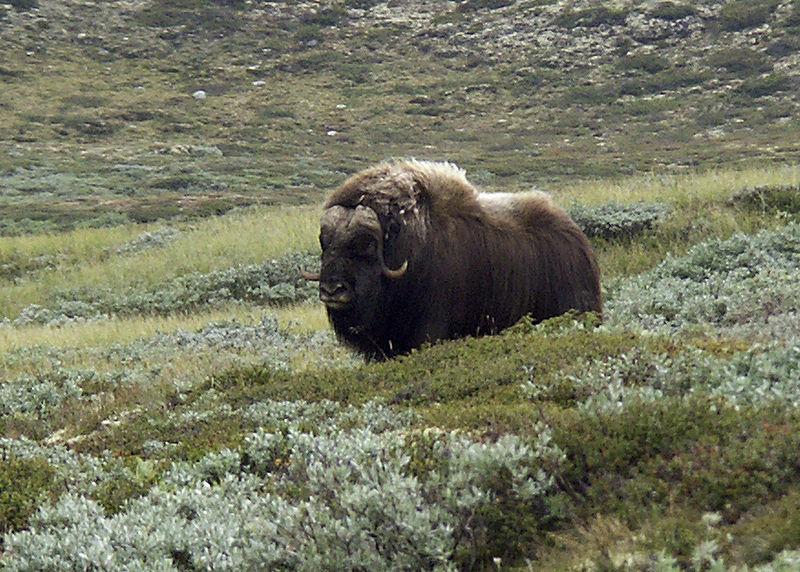Norway’s musk oxen provide warning of climate change consequences
The musk oxen in Norway’s in Dovrefjell National Park, Norway, are running into problems. As the climate changes, they’re an early warning of how warmer climates may killed certain species. (Photo by Pethr via Wikimedia Commons.)
Norway’s musk oxen are perfectly adapted to the bitter cold they’ve typically encountered.
Tord Bretten, a park ranger in Dovrefjell, Norway, is looking for the large, furry brown creatures. The oxen today are healthy, weighing a half a ton. But just a few years ago, that wasn’t necessarily the case.
“I was out every day and we found (dead) muskoxes all the time,” Bretten said.
That was in 2006. About 25 were found dead and another 60 went missing and were presumed to have died.
“I was a bit worried that the population could get extinguished. I grew up down here and I’m used to them, I like them. I’ve seen them almost all my life. It would be a pity if they disappear,” Bretten said.
There was no obvious cause of death, so Bretten turned to Bjørnar Ytrehus a vet with the Norwegian Veterinary Institute. Ytrehus was just as puzzled.
The animals had plenty of fat reserves. Their bellies were full of food. It looked like they’d just dropped in place. But then he looked at their lungs.
“The lower part of the lungs was dark, firm and with a lot of liquid inside, a bloody, watery, cut surface,” Ytrehus said. “These were signs of pneumonia.”
Ytrehus had seen this form of pneumonia, caused by Pasteurella bacteria, in sheep and reindeer before. Typically it’s caused by stress. But what was stressing out the musk oxen?
“The temperature in this period had reached an all-time high,” Ytrehus said.
The surprise warm-up happened in the fall, after the animals had already grown their winter coats, leaving them ill-prepared for record warmth.
“When they experience heat, they have to pant to get rid of the heat,” Ytrehus said. “And this will accumulate bacteria that normally are found in the throat into the lungs.”
And while the herd has recovered in the past five years, Ytrehus is worried that climate change may make this an enduring problem for Norway’s musk oxen.
“As the climate changes, the climate on the mountain will also change in a warmer and wetter direction,” Ytrehus said.
But it should be noted that the creatures aren’t exactly native to Norway. Though they once were, they died out at the end of the last ice age. In the 1940s, musk oxen from Greenland were brought to Norway and introduced in places with the types of climates where they could thrive. Ytrehus’ great-uncle took part in the transfer, so he’s especially attached to the animals.
“He was lending his sled dogs to the people who wanted to catch calves. He regarded that as one of the worst things he had done in his life,” Ytrehus said. “They killed the adult muskoxen to capture the calves. And the calves were crying for their mothers. And they brought the calves onboard the ship and took it back to Norway.”
Ytrehus said his great uncle views the musk oxen in Norway as the one redeeming quality of that effort, and doesn’t want to see them go. Plus, he thinks they might now be of some use to all of humanity.
Ytrehus sees these musk oxen as environmental sentinels, warning us about what could happen to animals in a world that’s getting warmer and wetter. The muskoxen were transplanted here to recall Norway’s past. But they may have more to say about the future.
Our coverage reaches millions each week, but only a small fraction of listeners contribute to sustain our program. We still need 224 more people to donate $100 or $10/monthly to unlock our $67,000 match. Will you help us get there today?
